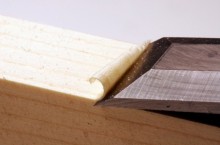A2 vs O1 Tool Steel
Article - June 11, 2009
An excellent question from Brian:
My question relates to tool steel. I am about to purchase a Veritas shoulder plane and for the first time am faced with the choice between A2 and O1 steel. I understand that A2 is the harder steel, which has the benefit of holding an edge longer and the detriment of being more difficult to sharpen. I understand that O1 steel is softer, allowing for easier sharpening to a keener edge, but one that will dull more quickly. Can you please confirm, to the degree you are able, that I am correct in my understanding here.
Secondly, can you let me know which steel you would choose and why? I am leaning toward the softer steel (O1 by my understanding) because I understand it is easier to sharpen to a keen edge. I am not going to put a lot of miles on this plane, so more frequent sharpening will not be a big burden to me. Thank you for your input. I continue to enjoy the site and The Guild.
Hey Brian. You are absolutely correct in your understanding of the difference between A2 and O1 steels. In general, O1 holds a slightly keener edge and is easier to sharpen. But it also dulls faster and require more frequent sharpening. A2 steel takes a little more effort to sharpen, but you are rewarded with a more durable edge that lasts longer.
As a person who uses a lot of exotic hardwoods and doesn’t enjoy sharpening any more than I have to, I prefer A2. When I am sharpening, it usually turns into an all day affair. So whether I’m using A2 or O1, I’m still getting messy and still spending hours getting my tools all prepped and ready to go. The A2 just ensures that I won’t be doing that as frequently. What you choose really does come down to personal preference.
Now I am by no means an expert in tool steel, so I thought I would go to someone who is for a more thorough answer. Here’s a reply from Ron Hock of Hock Tools:
 For our high carbon steel blades, HOCK TOOLS uses AISI (American Iron and Steel Institute) O1, a simple high carbon tool steel with very little added to the iron/steel alloy other than 1.1% manganese. That pinch of Mn allows the steel to harden with an oil quench (the “O” in O1 stands for Oil.) Oil removes heat more slowly than water, reducing the thermal shock that occurs when orange-hot steel is plunged into water. Reducing that thermal shock minimizes the risk of cracking or distortion in the hardened piece. With an alloy as simple as O1, containing so few alloying elements, the hardened grain structure is as fine as possible which allows honing to the sharpest possible edge.
For our high carbon steel blades, HOCK TOOLS uses AISI (American Iron and Steel Institute) O1, a simple high carbon tool steel with very little added to the iron/steel alloy other than 1.1% manganese. That pinch of Mn allows the steel to harden with an oil quench (the “O” in O1 stands for Oil.) Oil removes heat more slowly than water, reducing the thermal shock that occurs when orange-hot steel is plunged into water. Reducing that thermal shock minimizes the risk of cracking or distortion in the hardened piece. With an alloy as simple as O1, containing so few alloying elements, the hardened grain structure is as fine as possible which allows honing to the sharpest possible edge.
AISI A2 differs from O1 with the addition of 5% chromium and 1.1% molybdenum, allowing it to quench in still air (“A” for Air.) While “stainless” amounts of chromium (12% or more) make tool steel gummy and hard to sharpen, the modest amount of chromium in A2 improves its toughness and abrasion resistance, but imparts only a slight measure of corrosion resistance (like high carbon steel, it will rust and appropriate preventative care must be taken.) But there is a trade off. During heat treatment the chromium addition combines with some of the carbon in the alloy to form chromium carbides: tough, hard particles dispersed through the steel. These carbides are the primary contributors to A2’s celebrated edge retention. However, during heat treatment, the chromium carbides can grow quite large. Large enough to affect your ability to hone the edge as close to zero-radius as you may want. And these carbides are held in place with less strength than the rest of the steel matrix which can allow them to pop out under the stress of honing or cutting leaving a small gap in the edge.
A2 is one of the steels that respond well to cryogenic treatment. This extreme cold treatment (-320°F) essentially finishes the original quench, increasing the steel’s toughness without any decrease in hardness. You get increased wear resistance without any increase in brittleness so a cryogenically treated blade will hold its edge longer. You can keep working instead of sharpening. A2 is a great steel that offers a real improvement in edge retention. O1, on the other hand, is still preferred by many for its relative ease of sharpening and its ability to get sharper.





